Nestled in the woods of Waxahachie, a small town 30 minutes south of Fort Worth, the festival celebrates the life and times of the 16th century by inviting participants to rediscover the magic and transport themselves back in time by recreating the sights, sounds and smells of an authentic English village.
Prepare thyself for merriment Although often regarded as a time of hardship and frequent plague throughout Europe, the Renaissance period is also known as a time of enchantment, artistic expression and royal pageantry. For festival actors and employees, this means re-enacting a time of kings and queens, knights and nobles, dragons and unicorns. The year is 1533. With 10 stages of continuous entertainment, three full-combat, armored jousts daily and more than 200 artisans displaying colorful wares, participants stroll through the gravel and cobblestone streets completely distracted by the time warp and culture shock. Village shops and street vendors wind through the forest hills of the 35-acre fairgrounds. Flags of every color can be seen scattered throughout the festival, symbolizing the annual spring market fair. Actors, employees and professional craftsmen have made their pilgrimage in order to show off their wares for eight consecutive weekends.
Clothing
However, other participants choose to dress in keeping with the theme by wearing full-length cotton dresses for women, and tights and breeches (pants) for men. In fact, one of the first shops inside the village walls is a small hut offering costume rentals for the occasion. From full-metal armor for knights to cotton garbs for peasants, shop owners try their tools of persuasion and trickery to swindle a buck here and there from fair-goers. Clothing during the reign of Queen Elizabeth generally depicted the social status of the wearer. Expensive fabrics and dyes were generally seen as signs of nobility and were worn only on special occasions.
Food for all With menu selections from around the world, the fair's wafting aromas
lure participants from the grassy Although hundreds of fresh lemon peels are discarded from the lemonade vendor's cart, many people carry Smoothies, root beer floats and frozen margaritas.
Innovative skill and craftsmanship As one of the largest craft festivals in the nations, the Scarborough Faire hosts thousands of craft enthusiasts each year. Many participants choose to stroll through the streets with family and friends at their own pace, while others sit in on hands-on demonstrations of glass blowing, sword making, book binding, sand casting and candle making. Artisans engage in the dialogue and mannerisms of the age, including petty street vendors who dress in rags and roaming wenches selling magical wands and hair garlands.
Theater in the mud
Musical gazebos and countless side shows are scattered throughout the countryside, offering continual laughter and melody for participants who desire a rest along the way. Musicians play wooden flutes, guitars and drums and often dance happily across old wooden stages. At noon, the festival holds The Royal Procession, and hundreds of costumed characters flood the village, telling stories of imagination, enchantment and mystery. After a short walk through the Yorkshire Tower and Dungeons, participants observe a darker, more sinister side of the 16th century: A replica of a castle dungeon, the tower houses exhibits methods of interrogation and punishment. Throughout history, people of royal stature as well as peasants were brought to the dungeons to be interrogated. Many confessed to crimes just to escape torture in the dungeon. Interrogators used branding irons, wall mounts, hallucinogens and often
mace in order get prisoners to However, the tower and museum are not all dark, damp and infested with rodents and disease. The end of the tour leads participants into a small, white room titled The Crown Jewels, a glass casing displaying exact replicas of the British Royal Crown jewels. The bright and lavish jewels are examples of the pride and wealth of the royal family during the Renaissance period. Although merely replicas, the jewels sparkle with absolute elegance and wonder.
Easter service Opening the gates on Easter Sunday for the first time in 20 years, festival organizers designed some activities especially for children and families. Many small children participated in an Easter egg hunt and egg roll, while other children darted across gravel paths and through bushels of hay to neighboring rides and games scattered throughout the land of enchantment. Despite age or outfit, participants seemed to marvel at the sights and sounds of the 16th century. Even as the sun began setting and the fairgrounds started shutting down, eager participants hurried through the streets and villages, trying to catch a last glimpse of the crafts and booths nestled in the wooded countryside.
Matt Jones
Customs Customs and manners in the King Henry VIII's time were dictated by fashion, flirtation, survival and superstition. Listed below are some of the examples of the customs and manners of the time: Greetings Men greeting men Upon meeting one another, men would not shake hands in the custom of today. Rather, they would grasp each other's right wrists and shake firmly while patting each other on the back. Women greeting women Following the "French kiss," a custom still performed today, women would face each other, lightly grasp shoulders and kiss close to, but not touching, the other's cheeks. Men greeting women Women greeting men In Renaissance style, the man would bow to the woman while maintaining eye contact. She, in response, would curtsey. Fending off demons Witches, ghosts and demons were real to those living in the 16th century. Illness, accident and bad luck were blamed on evil forces. Religious faith, therefore, was strong. Most people were either Catholic or had been brought into King Henry VIII's Church of England. A cough or a sneeze, or even a mention of a cold (thought to be a sign of the plague) were reason to cross oneself. Werewolves and bad spirits were warded off with a clove of garlic worn on a string around the neck. The fork Another new trend from France was the use of the fork as a eating utensil. The fork was fairly common among the nobility, but its use was not widespread among the peasant class. Peasants continued to eat with their fingers, as they feared the fork's tines were a sign from the devil. Evil spirits/good luck charms Both peasants and nobles alike firmly believed in evil spirits and the power of good luck charms to ward them off. People often sewed tiny bells or coin-like metal disks (known as bezants) to their clothing in the belief that the noise would scare away evil spirits. People also wore crosses or carried Bibles to ward off evil.
By Justin Roche Skiff staff A gray, overcast sky blanketed with heavy clouds that threatened rain nearly spoiled the annual Easter egg hunt at Grandma's house. But, when it became clear the foreboding weather would not cancel our traditional search, it seemed an even gloomier force would stop it: my cousins.
But three years of college and a mission trip to Mexico my senior year of high school had prevented me from participating in the event for four years. In my return to our little holiday game, I was shocked that other's attitudes had changed dramatically since my last hunt. "Do we have to do it this year?" was the whiny cry from a cousin four years my younger. "Can't you just give us the eggs?!" Simply give out the eggs? My mind could not conceive of such a suggestion. Where was the fun? The tradition? The hunt? As I wrestled with the confusion, another piped in with his plea. "Yeah, I don't want to do it this year," he said, with all the authority that his 18 years of life afforded him against his elders. "We do this every year. Let's just get the candy and go." My head spun at the shock. Not one of my five cousins over the age of 16 wanted to take part in one of our only family customs. All of the laughter and smiles the hunt had brought us as children had been replaced with complaints and grumbles about how they were "too old" to search for "stupid little eggs."
Egg-xamining the revolution I pondered the last comment, as I was the second oldest of the crew and was in favor of keeping tradition alive and searching for the eggs. Perhaps I was merely four years behind the others, lost in the nostalgia of the event after my four-year absence. Or had I simply not become callous to what the hunt actually meant? More advocates for not having the hunt spoke up, drawing return fire from the adults, who lightly poked fun at the mini-mutiny threatening tradition. "Oh, come on, it'll be fun," said one aunt, her hands full of the elliptical treasures. "We do it every year. Why wouldn't you want to?" The reasoning behind most of the antagonistic behavior was because of how the hunt began. As all the children stayed in the house with the curtains drawn, a guardian adult tried to ensure no one could view the other parents outside in concealing the sought-after objects. Because the hunt had gone on for years, most of us knew we could expect to find three eggs inside the rusting barbecue grill that hadn't been used in 10 years, two behind the air conditioning unit that wasn't needed on this brisk Easter day and at least one in every one of Grandma's many ceramic flowerpots. "We already know where they're gonna be," stated one cousin, matter-of-factly, crossing her arms over her flowery dress that contrasted her disposition. "What's the difference between hunting for them and you just giving them to us?"
Being a bucket head My mouth went dry before I could respond. But as I nursed a nearby glass of water, the most potent evidence for not participating was voiced by my youngest cousin, the normally sweet-natured 16-year-old girl whose face had scrunched up so the level of her disgust was visible in number of wrinkles it had formed. "Well, I just don't want to wear that stupid bucket on my head!" Before the hunt could begin, all the cousins line up in the hallway according to age and place their plastic bucket on their heads as they walk out the door to meet a barrage of camera flashes and parent smiles. Once outside, the buckets that served as helmets would be removed and filled with bright vivid eggs that rattled with the treats within. The mere thought of the tradition brought a smile to my face, as I realized it was silly, but it was also a part of our childhood. Putting a bucket on my head seemed a small price to pay for sharing a memory with my family. But, as my wrinkled cousin stated her case, the others' voices became one unified whine, hoping to sway the parents through either guilt or sheer annoyance. They didn't care which, just so long as they got their way. Holding on to a childhood tradition Four years was all it took for one of my favorite family traditions to go from a beloved aspect of our childhood to something so despised as to be thrown away all together. Here we were, celebrating the holiday in which Jesus was raised from the dead, and it seemed our tradition had no chance of resurrection after most everyone gave the empty excuse, "I just don't want to do it." Two streams of thought fought for my allegiance: Do I remain loyal to my cousins and respect their wishes, contrary to my own as they may be? Or do I fight to hold on to a part of my past that I had waited four years to experience again? The eggs had all been hidden, with the adults proclaiming the hunt was about to begin. The cousins all sat in the dark brown carpeted living room, waiting for a leader to defy tradition and follow to the promised land of independence. As we sat in quiet save the rhythmic ticking of an old grandfather clock, begrudged faces looked to each other for a final answer. Reluctantly, one cousin picked herself up out of the aged, tan armchair and quickly marched toward the door, picking up a bucket and admitting a silent defeat. Another followed in the same fashion, grasping a plastic container with a bunny on its side and took large, angry strides after his cousin. Soon, with a muffled murmur, the rest resigned to prolonging their perceived torture one more year, gathering up the remaining buckets and placing them on their heads, just above their discourteous frowns and scornful glares.
From reluctance to joy Our emergence out of the house was met with flashes and the parents' joyous laughter as the hunt survived another year. But their laughter was soon drowned out by the shouts of the cousins, who were now fully and enthusiastically involved in the very event they had spurned only minutes before. Twenty-year-old men scrambled to beat each other to a bright pink egg in a budding oak tree or a sky blue one hidden under a green bush that sorely needed trimming. My 17-year-old cousin squealed with the same excitement she had 10 years ago when she found a dark purple egg concealed in the rusted mailbox. The contempt they had felt only moments before had been lost in the excitement of the hunt. Empty plastic egg carcasses were strewn about the living room after the hunt, their contents of gum drops, bubble gum and shiny coins having been taken and almost entirely consumed by the now allies of the annual hunt. Girls traded jellybeans to get the colors they craved, guys compared how much change they had accumulated and everyone agreed the hunt was worth the effort. Smiling, rolling a newly acquired butterscotch disk around in my mouth, I agreed. I just wished it hadn't been such an effort in the first place.
Justin Roche |
| The TCU Daily Skiff © 1998, 1999 Credits |
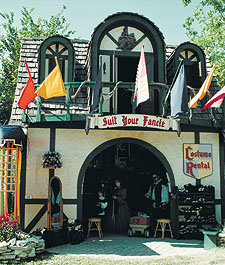 The sun beats down on the wooded site of the Scarborough
Faire, but the giant oak and shady pine trees provide shade and relaxation
for the Easter participants at the 20th anniversary Renaissance.
The sun beats down on the wooded site of the Scarborough
Faire, but the giant oak and shady pine trees provide shade and relaxation
for the Easter participants at the 20th anniversary Renaissance.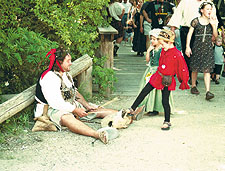 Dressed in light, summer clothing, many festival-goers sport
water bottles and sandals as they trample through the village streets passing
jugglers, jousters and jesters.
Dressed in light, summer clothing, many festival-goers sport
water bottles and sandals as they trample through the village streets passing
jugglers, jousters and jesters.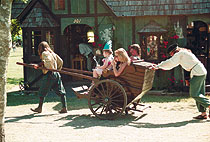 parking lot to
the entrance of the village. Many visitors eat under shaded tents and tavern
patios, while others walk the grounds carrying beer steins and waving wooden
sticks of roasted turkey legs and corn on the cob.
parking lot to
the entrance of the village. Many visitors eat under shaded tents and tavern
patios, while others walk the grounds carrying beer steins and waving wooden
sticks of roasted turkey legs and corn on the cob.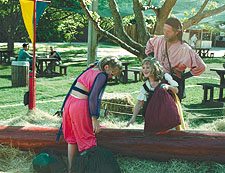 Although one of the festival's 10 stages
is devoted to a muddy comedy sketch loosely based on the story of Beowulf,
many of the fair's 10 stages are devoted to musical acts and styles representative
of the time.
Although one of the festival's 10 stages
is devoted to a muddy comedy sketch loosely based on the story of Beowulf,
many of the fair's 10 stages are devoted to musical acts and styles representative
of the time.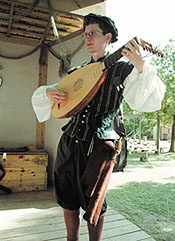 confess. The
tower houses an iron chair, usually heated and covered with metal spikes,
as well as a hanging cage and a torture wheel.
confess. The
tower houses an iron chair, usually heated and covered with metal spikes,
as well as a hanging cage and a torture wheel.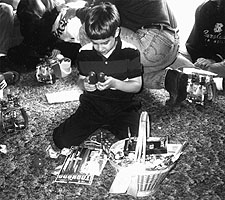 The hunt for brightly colored eggs containing
precious candy and coins within their plastic shells has been as much of
a part of my family's Easter as a chocolate bunny or going to church. With
an adequately sized bucket in one hand and a colorful discovered treasure
in the other, Easter became a bonding experience where a game and memories
brought joy to the gathered family.
The hunt for brightly colored eggs containing
precious candy and coins within their plastic shells has been as much of
a part of my family's Easter as a chocolate bunny or going to church. With
an adequately sized bucket in one hand and a colorful discovered treasure
in the other, Easter became a bonding experience where a game and memories
brought joy to the gathered family.